The Massacre at Wounded Knee: December 29, 1890
by Kathy Williams
The following is a sermon presented on Sunday, December 29, 2013 during worship designed to educate, remember and honor the Anniversary of the Massacre at Wounded Knee. Most of it is original writing based on the facts presented in “Bury My Heart at Wounded Knee: by Dee Brown. There are some parts (for example, the part about Captain Swenson) which were accessed on the internet.
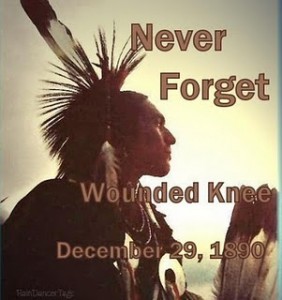 Ours is a vast and diverse nation and always has been. We have a lot of misconceptions about the founding of the United States of America, fueled by our wish to believe cowboy movies and school textbook versions of our ancestor’s gallant and brave entry into the new world. As is usually the case, there is a different story that is closer to reality and I’m about to tell you a part of it. Our church’s relationship with the Lakota Sioux people at the Pine Ridge Reservation in South Dakota has led us to study and have a beginner’s understanding of that reality. I’m going to tell you the sad story of the Wounded Knee Massacre which occurred on this day in 1890, but first I want you to understand the historical context in which it happened.
Ours is a vast and diverse nation and always has been. We have a lot of misconceptions about the founding of the United States of America, fueled by our wish to believe cowboy movies and school textbook versions of our ancestor’s gallant and brave entry into the new world. As is usually the case, there is a different story that is closer to reality and I’m about to tell you a part of it. Our church’s relationship with the Lakota Sioux people at the Pine Ridge Reservation in South Dakota has led us to study and have a beginner’s understanding of that reality. I’m going to tell you the sad story of the Wounded Knee Massacre which occurred on this day in 1890, but first I want you to understand the historical context in which it happened.
In 1868, a treaty was signed between the US Government and the Lakota guaranteeing them ownership of the Black Hills forever as well as hunting rights in South Dakota, Wyoming and Montana. The area was closed to white settlers and was known as the Great Sioux Reservation. Only four years later, illegal expeditions into the Black Hills found gold. Red Cloud and Spotted Tail went to Washington to make strong protests, and the response of Washington was to try to take away the Black Hills. The unwillingness of the Sioux to give up their sacred land led to them being labeled “hostile” and soldiers began attacking peaceful camps on the Reservation, killing women and children and destroying teepees, food and clothing. The next period, from 1868 to 1876, resulted in numerous battles. One foolhardy leader who wanted to make a name for himself in Washington, George Armstrong Custer, headed toward Little Bighorn. The rest is history. Custer and all of his men were killed in battle by the Indians in defense of their land. The battle was labeled a “massacre” by Washington despite the fact that the US soldiers were the aggressors. The treaty of 1868 was then disregarded and the Indians were punished by the taking of military control of all the reservations in Sioux country and all Indians were treated as prisoners of war.
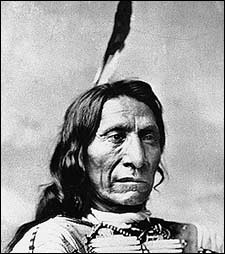 Under duress and as prisoners of war, Red Cloud and his sub-chiefs signed an agreement in 1876. They were told if they did not sign, their guns and horses would be taken away, they would have no rations, and they would be moved. The Black Hills were stolen by the United States Government from the Sioux Indians. Despite signing, four weeks later their guns and horses were stolen and all males were placed under arrest.
Under duress and as prisoners of war, Red Cloud and his sub-chiefs signed an agreement in 1876. They were told if they did not sign, their guns and horses would be taken away, they would have no rations, and they would be moved. The Black Hills were stolen by the United States Government from the Sioux Indians. Despite signing, four weeks later their guns and horses were stolen and all males were placed under arrest.
Another of their leaders, Chief Sitting Bull had been in exile in Canada. He was hoping that the Canadian government would give him and his people land to live in peace, but their request was denied. On July 19, 1881, Sitting Bull and his followers crossed the Canadian border. Despite the promise of the US Government of a pardon if he returned, no such pardon ever happened. Sitting Bull was such a strong leader that he was considered highly dangerous.
At this time, a religious fervor took hold among the Indian People. There was a belief that the ghosts of Indians would return to inhabit the earth. They were told of the coming of Christ and they believed that the Messiah would return to earth in the spring. This new religion gave the people much hope and it was expressed in a dance, wearing sacred garments. They believed that when wearing the sacred garments of the Ghost Dance, no harm could come to them.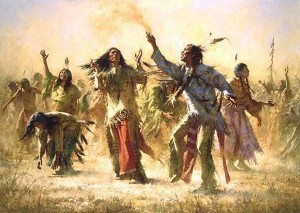
Have we not all had moments when in times of trouble and tribulation, our faith in God provides reassurance and hope? At a time when the white men were attempting to take away the Native spiritual practices and replace them with Christianity, they failed to recognize that the Ghost Dance was in fact Christianity. The rituals were different, but the tenets were the same: nonviolence and love. The doctrine called upon them to only dance and sing and wait for the coming of the Messiah. The dancing became so popular on the Sioux reservation that no work was being done. The US Soldiers became frightened and called the movement “wild and crazy.”
Despite evidence to the contrary, the frightened US Army decided that the Ghost Dance must be the work of the powerful Sitting Bull, and on December 12, 1890 orders were given to “secure the person of Sitting Bull.” On December 15, 1890, 43 Indian police surrounded his cabin to take him prisoner on behalf of the US Army. Sitting Bull agreed to go, but when they exited the cabin, a crowd of Ghost Dancers gathered outside, stating that they would not allow Sitting Bull to be taken. Sitting Bull resisted, a gun fight ensued and a bullet accidentally hit Sitting Bull through the head, killing him.
Had it not been for the sustaining force of the Ghost Dance religion, the Sioux in their grief and anger over the death of Sitting Bull might have risen up. Instead, they made no retaliation and sought refuge in one of the Ghost Dance camps or with one of the remaining leaders, Red Cloud who was at Pine Ridge.
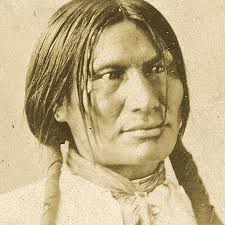 One of the leaders that the War Department wanted to arrest was Big Foot. When Big Foot heard of the death of Sitting Bull, he rounded up his people and headed them to Pine Ridge, hoping the Red Cloud could protect them from the soldiers. En route, he fell ill from pneumonia. On December 28, 1890, US Army soldiers approached and Big Foot immediately ran a white flag up over his wagon. Despite his illness, he raised from his blankets and met with Major Samuel Whiteside, Seventh US Calvary. Whiteside told him that he had orders to take him to a cavalry camp on Wounded Knee Creek. Big Foot replied that he was headed that way, intending to take his people to Pine Ridge for safety. Whiteside ordered that the Army Ambulance transport the ailing Big Foot, with the Indians herded into a compact group behind them. When they reached the Calvary tent camp at Wounded Knee Creek, the Indians were counted. There were 120 men and 230 women and children. Because of the gathering darkness, it was decided to wait until morning to disarm the prisoners. Rations were issued and, as there was a shortage of teepees, several tents were furnished. A stove was placed in Big Foot’s tent and a surgeon sent to administer to him. To make sure that no one escaped, they were surrounded by armed sentinels.
One of the leaders that the War Department wanted to arrest was Big Foot. When Big Foot heard of the death of Sitting Bull, he rounded up his people and headed them to Pine Ridge, hoping the Red Cloud could protect them from the soldiers. En route, he fell ill from pneumonia. On December 28, 1890, US Army soldiers approached and Big Foot immediately ran a white flag up over his wagon. Despite his illness, he raised from his blankets and met with Major Samuel Whiteside, Seventh US Calvary. Whiteside told him that he had orders to take him to a cavalry camp on Wounded Knee Creek. Big Foot replied that he was headed that way, intending to take his people to Pine Ridge for safety. Whiteside ordered that the Army Ambulance transport the ailing Big Foot, with the Indians herded into a compact group behind them. When they reached the Calvary tent camp at Wounded Knee Creek, the Indians were counted. There were 120 men and 230 women and children. Because of the gathering darkness, it was decided to wait until morning to disarm the prisoners. Rations were issued and, as there was a shortage of teepees, several tents were furnished. A stove was placed in Big Foot’s tent and a surgeon sent to administer to him. To make sure that no one escaped, they were surrounded by armed sentinels.
In the morning, there was a bugle call and hardtack was issued for rations. The Indians were informed that they were now to be disarmed. Guns were given and stacked. They were not satisfied that this was all the weapons, so the teepees and tents were searched. Axes, knives and tent stakes were then piled next to the guns. Still not satisfied, the soldiers ordered the Indians to remove their blankets and submit to searches. Their faces showed their anger, but only the medicine man Yellow Bird made any overt protest, by dancing the Ghost Dance and chanting. He reassured the Indians that the soldiers’ bullets could not penetrate their sacred garments.
Two additional rifles were found, one a Winchester belonging to a young deaf man, Black Coyote. He raised the rifle over his head, shouting that he paid much for the rifle and that it was his. It is believed that he intended to put the rifle down, but the soldiers grabbed him and the gun went off. It is not believed that he intended to shoot the rifle and that he intended to put it down.
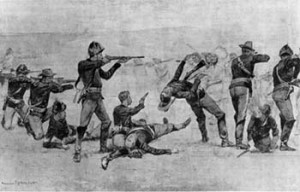 Immediately, the soldiers returned the fire and indiscriminate killing began. Big Foot was among the dying, sprawled onto the frozen ground. As few of the Indian had weapons, they began to flee and soldiers with large Hotchkiss guns on the hills opened up, firing almost a shell a second, shredding the teepees with shrapnel, killing men, women and children.
Immediately, the soldiers returned the fire and indiscriminate killing began. Big Foot was among the dying, sprawled onto the frozen ground. As few of the Indian had weapons, they began to flee and soldiers with large Hotchkiss guns on the hills opened up, firing almost a shell a second, shredding the teepees with shrapnel, killing men, women and children.
Eyewitness accounts report mothers shot down with their infants, children nursing their dead mothers, and little boys lured out from places of refuge, then surrounded by soldiers who butchered them.
When the madness ended, 153 were known dead, including Big Foot and many of the wounded crawled away to die afterward. The final total of dead was nearly 300 of the approximately 350 in the camp. The soldiers lost 25 dead and 39 were wounded. Almost all of these were struck by their own bullets or shrapnel.
A detail of solders gathered up Indians who were still alive and loaded them into wagons. A blizzard was approaching, and the dead Indians were left lying where they had fallen. After the blizzard, a burial party returned and found the bodies frozen into grotesque shapes. They were buried in a mass grave.
Wagonloads of 4 men and 47 women and children were taken to Pine Ridge. The wounded were left in open wagons in the bitter cold while an inept Army officer searched for shelter. Finally the Episcopal mission was opened, the benches taken out, hay scattered on the floor.
The date was December 29, four days after Christmas. Just as our church is now, the mission was decorated with garlands of greenery and candles. In the chancel above the pulpit, a crudely lettered banner was strung, : PEACE ON EARTH, GOODWILL TO MEN.
In a confidential letter Major General Nelson A. Miles (the General of the Army, in 1890, during the time of the Wounded Knee Massacre) lamented the loss of life during the Wounded Knee Massacre, of both the soldiers and the Lakota. He criticized the placement of the soldiers which placed them at risk for “friendly fire” as well.
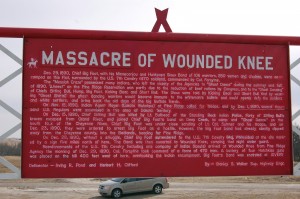 “Wholesale massacre occurred and I have never heard of a more brutal, cold-blooded massacre than that at Wounded Knee. About two hundred women and children were killed and wounded; women with little children on their backs, and small children powder burned by the men who killed them being so near as to burn the flesh and clothing with the powder of their guns, and nursing babes with five bullet holes through them. Col. Forsythe is responsible for allowing the command to remain where it was stationed after he assumed command, and in allowing his troops to be in such a position that the line of fire of every troop was in direct line of their own comrades or their camp.”
“Wholesale massacre occurred and I have never heard of a more brutal, cold-blooded massacre than that at Wounded Knee. About two hundred women and children were killed and wounded; women with little children on their backs, and small children powder burned by the men who killed them being so near as to burn the flesh and clothing with the powder of their guns, and nursing babes with five bullet holes through them. Col. Forsythe is responsible for allowing the command to remain where it was stationed after he assumed command, and in allowing his troops to be in such a position that the line of fire of every troop was in direct line of their own comrades or their camp.”
The Congressional Medal of Honor is the highest military award for bravery that can be given to any individual in the United States of America. After the Wounded Knee Massacre, 20 soldiers of the 7th Calvary were awarded Medals of Honor for their participation and those Medals of Honor still stand today. A Medal of Honor is given when a soldier distinguishes him or herself by gallantry and risk of life above and beyond the call of duty.
I want to give you an example of another Medal of Honor recipient. The most recent recipient of the Medal of Honor was Captain William D. Swenson, US Army soldier in Afghanistan, in October 2013. With complete disregard for his own safety, Captain Swenson unhesitatingly led a team in an unarmored vehicle into the kill zone, exposing himself to enemy fire on at least two occasions, to recover the wounded and search for four missing comrades. After using aviation support to mark locations of fallen and wounded comrades, it became clear that ground recovery of the fallen was required due to heavy enemy fire on helicopter landing zones. Captain Swenson’s team returned to the kill zone another time in a Humvee. Captain Swenson voluntarily exited the vehicle, exposing himself to enemy fire, to locate and recover three fallen Marines and one fallen Navy corpsman. His exceptional leadership and stout resistance against the enemy during six hours of continuous fighting rallied his teammates and effectively disrupted the enemy’s assault. Captain William D. Swenson’s extraordinary heroism and selflessness above and beyond the call of duty are in keeping with the highest traditions of military service.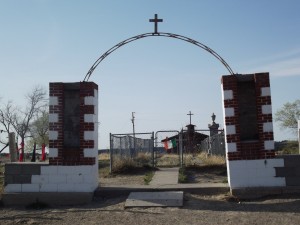
Where was the gallantry at Wounded Knee when unarmed women, children, including toddlers and infants, were shot at point blank range. Where is the honor? Clearly, this was not heroism, it was cold-blooded murder! To the Lakota Sioux, it is as if December 29, 1890 was yesterday and to them it was one of the most significant events in world history. The fact that our government continues to honor the murderers of their people is a wound that stays open. U.S. Army proudly displays the “Pine Ridge 1890-1891” battle streamer on the army flags displayed at the Pentagon and will continue to do so unless the Wounded Knee Medals of Honor are rescinded by the President and Congress.
 So now you know. I have told you the story of the Wounded Knee Massacre, and never again can anyone in this room argue “I would have done something but I didn’t know.” We as a people can no longer look the other way. The Medals of Honor at Wounded Knee are an injustice. Rev. Wendy is making available today at coffee hour the opportunity to sign an online petition requesting that the President of the United States rescind the Wounded Knee Medals of Honor. In addition, our Team has requested a meeting with Senator Elizabeth Warren to discuss Wounded Knee as well as the conditions we have observed in our travels to Pine Ridge. You are invited today to join us and take a step on the path of justice for the Lakota Sioux. In a democracy we as individuals are responsible for the actions of our government. We have a right and a duty to support the Lakota people. Thank you for listening to this painful and difficult story and may God walk with us in our journey toward the light.
So now you know. I have told you the story of the Wounded Knee Massacre, and never again can anyone in this room argue “I would have done something but I didn’t know.” We as a people can no longer look the other way. The Medals of Honor at Wounded Knee are an injustice. Rev. Wendy is making available today at coffee hour the opportunity to sign an online petition requesting that the President of the United States rescind the Wounded Knee Medals of Honor. In addition, our Team has requested a meeting with Senator Elizabeth Warren to discuss Wounded Knee as well as the conditions we have observed in our travels to Pine Ridge. You are invited today to join us and take a step on the path of justice for the Lakota Sioux. In a democracy we as individuals are responsible for the actions of our government. We have a right and a duty to support the Lakota people. Thank you for listening to this painful and difficult story and may God walk with us in our journey toward the light.
